The piece of the month of May 2020
A DIAMOND RIBBON GIVEN BY QUEEN MARIANA OF NEOBURG TO OUR LADY OF THE WAY OF PAMPLONA
Ignacio Miguéliz Valcarlos
Chairof Navarrese Heritage and Art
University of Navarra
Our Lady of the Way, compatrona of Pamplona, received throughout history a great issue of donations of jewelry from the faithful. In fact, it was probably the Marian image of greatest devotion in the city, ahead of other advocations such as Nuestra Señora la Real or del Sagrario, titular of the cathedral, Nuestra Señora de las Maravillas, in the convent of Agustinas Recoletas, or San Fermín himself, who is undoubtedly the most popular figure in the city today. The absence of a rich trousseau is not due, as we have mentioned, to the lack of donations to the Virgin in past times, which she had them and of great wealth, nor to the seizure of jewels that suffered the churches of Pamplona, and Navarre in general, during the wars that devastated Spain throughout the nineteenth and twentieth centuries. This lack is due to the fact that the pieces that Our Lady of the Way received as gifts and offerings from her faithful were auctioned in popular raffles to raise funds for the construction and decoration of her chapel throughout the 19th century. In the second half of the seventeenth century there was a need to enlarge the chapel dedicated to the Virgin of the Way in the church of San Saturnino, because the one it occupied had become too small. It was not until 1756 when, in the heat of the construction fever that was experienced in Pamplona, and in imitation of the chapel that the city council of Pamplona had built in honor of San Fermín in the church of San Lorenzo, the San Saturnino workers decided to renovate the chapel of the Virgen del Camino by building a new one. With this they wanted to demonstrate the strength not only of their faithful but of the work itself, which was demonstrated by the rapid execution of the works and the richness of its decoration, including not only the chapel, with its altarpieces and other movable elements, but also the chapel of the Virgin and the sacristy, all of which were built between 1757 and 1776.
As we have already mentioned, in order to defray the costs of the new constructions and their adornment, the church workers decided to sell and raffle off the Virgin's trousseau, keeping only the jewels essential for her ornamentation.
I certify that having been resolved by the Obreria and Deputies of which the said Parish is composed to build a new Chapel for the placement of the Image of Our Lady of the Way, School was granted to dha Obreria by Order of January twelfth of the year that is on page two hundred and thirty-two of the book of that, to proceed with the disposal that has the same Our Lady, reserving those who had as necessary for worship.
In general, the sale was made through a public raffle, which, contrary to what it might seem, did not diminish the gifts to the Virgin, collecting throughout the modern age a multitude of gifts, from simple pieces to other richer ones, the donors belonging to the entire social spectrum of the city, with the viceroys and the nobility at the head.
One of the most important legatees recorded in the documentation of the chapel is Queen Mariana of Neoburg (1667-1740), widow of King Charles II (1661-1700), who resided in Pamplona for approximately seven months, between September 25, 1738 and April 23, 1739, after her return to Spain after spending 30 years in exile in Bayonne. The chronicle of her visit was collected by the prior of the cathedral, Don Fermín de Lubián y Sos (1689-1770), as well as by the chronicles of the Cathedral and the City Hall. These chronicles give a detailed account of the queen dowager's stay, including her visits to the different churches and images of the capital. In spite of the honor that the visit of a queen meant for a city at this time, a series of conflicts were generated during her stay, especially protocol, so the queen's departure for Guadalajara was received with relief, the city where she set up her residency program since she was not allowed to do so in the Court, where she would die in 1740.
During her stay in Pamplona, Doña Mariana showed a special devotion to Nuestra Señora del Camino and, at her request, a novena was organized in honor of the Virgin, which the queen attended every day. During this novena the sovereign gave the image a ribbon of gold and diamonds, the same with which it was adorned that day, stripping it theatrically to place it on the image, as well as a reliquary with the Holy Face and two briales, subject of female clothing, to make a dress for Our Lady and ornaments for the chapel.
S.M. by his own hand has put to the said holy image a jewel of diamonds of those of his royal use, which in addition to its great value brought for the esteem of the parish to be alaja of his royal person and is in the circumstances of having lengthened S.M. two briales of its own adornment and use so that they were used in a dress for the holy ymagen and others that seemed convenient and it was for greater virtue of its protector and advocate and in effect it has been made dress, curtain, chasuble, frontal, bag of corporal and cloth of on calice, which has remained as Rico as Regio, because although the fabric is of silver in white field, S.M. explaining his zeal and piety, at his own expense has paid for all the gold gallon that has been necessary for the greater adornment of the chasuble and others.
Although the account does not specify which subject jewel, valued by the silversmith José de Yavar at 12,000 reales, was the one given by the queen, in later annotations it is described as "a silver Joia in the form of a ribbon with gilded reverse with sixty-one grown diamonds, the fifty-five roses, four bottoms and the remaining tables that she gave and put by her hand to Our Lady the widowed Queen Mariana de Neoburg".
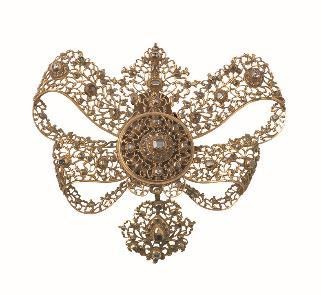
Lazo. Pamplona. Second quarter of the 18th century. Pamplona Cathedral.
The ribbon was a jewel subject worn by women on the chest and whose typology derived from textile ornaments. It was a very common piece in the seventeenth century, and could be used either as an ornament on women's necklines, or at the throat, with the name of 'neck jewel' and held by a ribbon. Formally it was composed of a double loop joined in a central rosette, which presented its openwork and trimmed surface and with gemstone settings. Other elements could be added to this central core, such as a topknot, almond and cross.
Both models of ribbon appear among the jewels that aspiring master gold silversmiths could choose as an examination piece according to the ordinances of the Pamplona silversmiths' guild. The first of them, "a loop of curled guides and cardboard handmade with twenty-one stones in the upper leaves, and sixteen in the lower ones, with a band and its pendant, all nailed in fine gold or silver", was chosen as an examination piece by Manuel Montero in 1743; while the second, "an ornament of a cross with a corresponding loop with sixty-one fine stones nailed with small peppitas, all handmade, in gold or silver", was chosen by Joaquín María Yoldi in 1788, which demonstrates its survival in Navarre throughout the century.
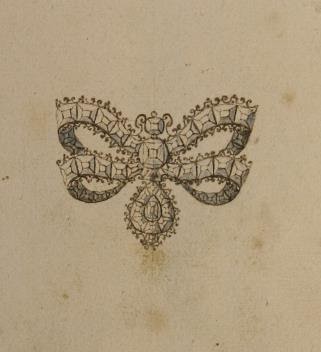
Examination drawing by Manuel Montero. Pamplona. 1743. Pamplona.
file Municipal.
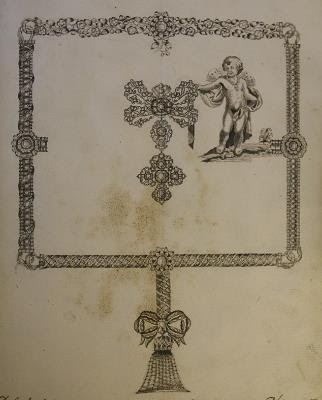
Examination drawing by Joaquín María Yoldi. Pamplona. 1788. Pamplona.
file Municipal.
This typology evolved throughout history, surviving to the present day in the form of a brooch. Although we have no image of the jewel given by Doña Mariana, several pieces of the same typology and period have been preserved in different churches in Navarre, such as the three ribbons that are set in the rosette of the Virgen del Camino, those belonging to the trousseau of the Virgen del Sagrario of the cathedral of Pamplona, or those of the church of San Miguel de Aoiz and the monastery of Tulebras. There are also numerous preserved portraits of Doña Mariana de Neoburgo in which she appears wearing different ribbons and other jewels on her chest.
Given the symbolic importance of the jewel given by the sovereign, which linked Nuestra Señora del Camino with the Royal House and served as a lure for other donations, this piece was always excluded from the disposal of the Virgin's jewelry to raise funds, remaining in her trousseau.
I certify that having been resolved by the workers and deputies of which the aforementioned parish is composed to build a new Chapel for the placement of the image of Our Lady of the Way, it was granted School to said workers, by order of January twelfth of this year, to proceed to the alienation of the boxes that has the same Our Lady, reserving those who tubiere as necessary for worship, and with specialization program which gave the lady Mrs. Maria Ana de Neoburg Widow Queen of Spain.
This piece appears in the successive inventories of the Virgin's jewelry until 1777, noted in an individual entrance : "Plus a silver jewel in the shape of a ribbon with gilded reverse setting, and with sixty-one grown diamonds, the fifty-five pink, four bottoms and the remaining tables that the Dowager King Doña Mariana de Neoburg gave and put by her hand to Our Lady". However, in the inventory made in 1794 with the list of pieces that were sent to Calahorra to protect them from the French invasion, the individual entrance disappears and the queen's jewel set in a crown is noted: "A large gold crown of Our Lady adorned with the Jewel of the Queen ....", a piece that had been made, as recorded in the documentation, in 1784, using the ribbon to give greater richness to the work, but without failing to note its affiliation with the sovereign. This jewel appears again in the inventory of pieces of 1836 and 1837, which includes the works given to the Provincial Council by the church of San Saturnino during the First Carlist War, and, although its royal provenance is no longer mentioned, its description fits the jewel given by the queen: "A crown of the Virgin adorned with a ribbon that makes a front of pink diamonds ...". After this last inventory, both the crown and the queen's jewel that was superimposed on it do not appear again among the Virgin's properties, so it is to be assumed that the piece was not returned to the chapel and that it was used to defray expenses generated during the war.
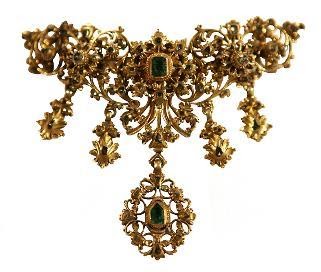
Peto. Pamplona. First half of the eighteenth century.
Chapel of the Virgen del Camino de Pamplona.
Of all the rich collection of jewelry that Our Lady of the Way received throughout history, there are only a few pieces left today, almost all of which can be dated from the end of the 19th century. Prior to these dates, only a breastplate from the first half of the eighteenth century is preserved, made of gold, diamonds and emeralds, which may have been treasured because it was mistaken for the piece given by the queen; As well as a small rostrum of the Virgin made in 1914 by the silversmith Esteban Garcia, which sets several old jewels, including three small gold and diamond ribbons, works of the second third of the eighteenth century and that, due to the material with which they are made and the issue of stones they present, do not match with the one given by the queen.
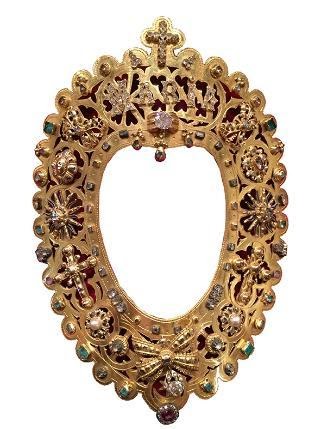
Rostrillo. Esteban García. 1914. Chapel of the Virgen del Camino de Pamplona.
SOURCES AND BIBLIOGRAPHY
file parish of San Saturnino. Books of conference proceedings of the Obrería de San Saturnino and various papers of the Chapel of Nuestra Señora del Camino.
ARDANAZ IÑARGA, N., "protocol y ceremonial del Cabildo pamplonés en el siglo XVIII: Estancia de la reina viuda, Mariana de Neoburgo en Pamplona (1738-1739)", in R. Fernández Gracia and M.ª C. García Gainza (Coords.), programs of study sobre la catedral de Pamplona in memoriam Jesús M.ª Omeñaca, Cuadernos de la Chair de Patrimonio y Arte Navarro, n.º 1, Pamplona, University of Navarra, 2006, pp. 411-431.
GARCÍA GAINZA, M.ª C., Ancient drawings by the silversmiths of Pamplona, Pamplona, University of Navarra, 1991.
GARCÍA GAINZA, Mª. C. et al., Catalog Monumental de Navarra. Merindad de Pamplona. Volume V***, Pamplona, Government of Navarra - Archbishopric of Pamplona - University of Navarra, 1998, pp. 121-125.
MIGUÉLIZ VALCARLOS I., "El joyero de la Virgen del Sagrario en los siglos del Barroco", in R. Fernández Gracia and M.ª C. García Gainza (Coords.), programs of study sobre la catedral de Pamplona in memoriam Jesús M.ª Omeñaca, Cuadernos de la Chair de Patrimonio y Arte Navarro, n.º 1, Pamplona, Universidad de Navarra, 2006, pp. 227-257.
MIGUÉLIZ VALCARLOS I., "San Fermín", in R. Fernández Gracia and M.ª C. García Gainza (Coords.), programs of study sobre la catedral de Pamplona in memoriam Jesús M.ª Omeñaca, Cuadernos de la Chair de Patrimonio y Arte Navarro, n.º 1, Pamplona, University of Navarra, 2006, pp. 297-320.
MIGUÉLIZ VALCARLOS I., Joyería en Navarra. 1500-1900, Pamplona, Chair de Patrimonio y Arte Navarro, 2019.
MOLINS MUGUETA, J. L. and FERNÁNDEZ GRACIA, R., "La capilla de Nuestra Señora del Camino", in La Virgen del Camino de Pamplona. IV Centenary of its appearance (1487-1997), Pamplona, Mutua de Pamplona, 1987, pp. 61-117.
